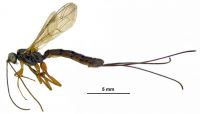ICHNEUMONIDAE: : Phytodietus Gravenhorst 1829
Diagnosis:
Phytodietus is relatively simple to identify. There are very few taxa it can be confused with. However, it is not commonly encountered. It has a relatively distinct body colouration, with very yellow hind femora and black hind tibia.Characteristics of Phytodietus include: 1. Body size just slightly <10mm; 2. Position of spiracle on Tergite 1 is at the centre; 3. Shape of aerolet in forewing is petiolate; 4. Colour of face is not all black; 5. Metasoma is compressed laterally; 6. Ocelli are small; 7. Length of antennae are as long as the body; 8. Length of ovipositor is distinct but not longer than body; 9. Wings are present; 10. Colour of wings are hyaline (clear); 11. Sternaulus (on mesopleuron) is absent; 12. Shape of face in lateral view is flat or only weakly bulging; 13. Sternite on T1 (viewed laterally) is not extending past spiracle; 14. Shape of T1 (viewed laterally) is evenly curved; 15. Number of teeth in mandibles is 2; 16. Patterns on metasoma is the same colour throughout (black, dark brown); 17. T1 longer than T2; 18. Sculpture on mesoscutum is smooth, very polished; 19. Width of T1 (viewed dorsally) is generally of uniform width (slightly widening posteriorly); 20. Glymma on T1 is present as a deep pit that produces a small hole in T1; 21. Sculpture on metasoma is smooth with a glossy appearance (highly polished, no punctures); 22. Propodeum reaching just past the coxal insertion, but not reaching halfway along metacoxae.
Similarity to Other Taxa
Phytodietus is a mid-sized Ichneumonid in New Zealand. They are siimilar in size to: Dusona , Liotryphron , Habronyx , Lissonota and Venturia . It can be separated from other similar sized taxa by having a deep glymma on T1, the ovipositor length distinct but not longer than the body, a petiolate areolet in the forewing.Compare
-

Liotryphon
T1 squat, dorso-ventrally compressed ( Phytodietus is laterally compressed). -

Lissonota
Glymma present as groove (not deep pit), ovipositor as long as body, mesoscutum not polished but finely pitted. -

Dusona
Ovipositor length very short, spiracle on T1 well behind the centre of T1. -

Habronyx
Ovipositor length very short, no areolet in forewing, spiracle on T1 well behind the centre of T1. -

Venturia
Metasoma bicoloured (orange/black), spiracle on T1 well behind the centre of T1. -

Netelia
Phytodietus can be separated from Netelia, the only other genus of Tryphoninae in New Zealand, by being a smaller size, having yellow/brown/black body colouration (vs brown throughout), and having small ocelli. Both species of Netelia are well over 10mm in length and have very large ocelli.
Distribution in NZ
North Island: AK, BP, CL, GB, HB, TO, WN, RI. South Island: NN, BR, MC, DN, CO, WD, FD, SI, SL.
Species in NZ
One endemic species Phytodietus zealandicus (Ashmead 1900).Biology & hosts
Phytodietus is a large cosmopolitan genus around the world, but the New Zealand species is placed in its own subgenus, Euctenopus . Little is known about the biology or host of Phytodietus zealandicus , however, it is nocturnal. It is widespread in New Zealand and has also been collected from a wide range of habitats, such as urban areas, beech forest, swamps, and coastal lagoons/beaches.Sources of information
Gauld ID 1984. An Introduction to the Ichneumonidae of Australia. London, British Museum (Natural History). 413 p.Parrott AW. 1951. New Zealand Ichneumonidae. I. The genus Netelia Gray. ( Paniscus of authors) (Tryphoninae: Phytodietini). Transactions of the Royal Society of New Zealand (Zoology) 79: 286-293.
Citation
Ward DF & Schnitzler FR. 2013. Ichneumonidae of New Zealand. Genus Phytodietus http://ichneumonidae.landcareresearch.co.nzAccessed: 10 March 2025


